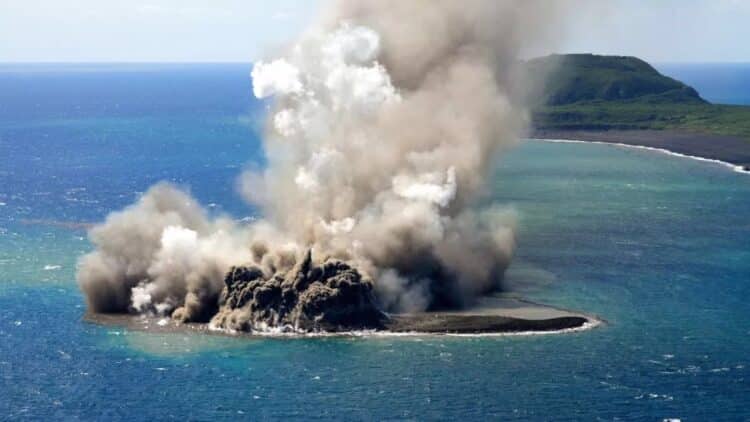The idyllic island of Santorini has been rocked by more than 8,000 earthquakes in recent weeks, sparking fears that the underwater Kolumbo volcano could be on the brink of eruption. With a growing magma chamber discovered beneath the seabed and scientists keeping a close eye on seismic activity, it raises questions of whether Santorini is about to experience another catastrophic eruption like the one that hit in 1650. The repercussions of such an eruption could be disastrous, not only for Santorini but for the broader region.
A growing magma chamber has been discovered beneath the Kolumbo volcano in Santorini
According to a recent study that was published in Geochemistry, Geophysics, Geosystems, a previously undetected, growing magma chamber has been discovered beneath the Kolumbo submarine volcano northeast of Santorini.
This finding has escalated fears since magma accumulation is commonly an indicator of imminent volcanic eruption. The island of Santorini and its immediate vicinity are part of the Hellenic Volcanic Arc, an area with a lot of seismic and volcanic activity.
According to researchers from the National Institute of Geophysics and Volcanology, a series of earthquakes rattling Santorini are taking place along the Santorini-Amorgos fault zone, a region with the potential to generate high-magnitude earthquakes.
Historically, the region experienced its most destructive earthquake in 1956, which registered a 7.1 magnitude, followed by a tsunami that devastated large areas. But the combination of tectonic movement and a growing magma chamber means that Kolumbo needs to be watched closely, though the chance of an eruption is uncertain. Scientists are especially concerned about possible submarine landslides, which could generate tsunamis and endanger coastal residents.
Santorini declares a state of emergency as seismological activity increases
In response to the increasing seismological activity, the Greek authorities have taken immediate measures. A state of emergency has been declared in Santorini, and the authorities have closed schools, ordered residents to drain swimming pools to avoid structural damage, and restricted access to high-risk areas after the reporting of landslides.
More than 11,000 people, residents and tourists, have already evacuated from the island as fears grow that the island will experience a major geological event. Kyriakos Mitsotakis Grek, Prime Minister, gave a TV statement telling the citizens that although the situation is worrying, everything precautionary is being done.
But scientists, including Michele Paulatto, an Advanced Research Fellow in Volcano Geophysics, say that monitoring the situation is more important than speculation at this stage. He adds that while quakes can occasionally lead to eruptions, the shaking has mostly taken place far away from the volcano (just like this supervolcano, which scientists are going to drill into) itself.
However, if earthquake activity begins to migrate immediately beneath Kolumbo, the chances of an eruption would rise dramatically. The last significant eruption of Kolumbo in 1650 caused widespread destruction; pyroclastic flows killed roughly 70 people, and a suspected tsunami inundated coastal regions. If an eruption like the one in 1956 happened today, it might result in much more extensive destruction, particularly given the population density and tourism-dependent economy of Santorini.
Experts monitor Santorini’s volcanoes with new seismic tools
In response to the surge of seismic activity, an international team of researchers has installed four cutting-edge portable underwater seismographs inside Kolumbo’s caldera and along a submarine fault of Anydros. Both instruments monitor microseismic activity, ground movement, and changes in water chemistry, all signs of volcanic disturbance.
Developing these new tools is part of the research team’s broader goal, which, along with experts from the GEOMAR Helmholtz Center for Ocean Research and the University of Potsdam, is to use them to obtain a clear picture of the evolving situation under Santorini.
The data collected will be analyzed in conjunction with measurements from the SANTORY underwater observatory, which has been monitoring Kolumbo’s activity since December 2022. “This process is ongoing,” says Evi Nomikou, a professor of Geological Oceanography at the National and Kapodistrian University of Athens, who emphasizes the need for continued research and funding to continue monitoring efforts.
Nomikou remembers the geological crisis of 2011 – 2012, in which Santorini had 14 months of heightened activity without an eruption. This also reminds us that not all seismic activity leads to a volcanic eruption, but surveillance via monitoring will always be important for providing early warning and preparation for a potential disaster.
Santorini remains seismically active, with magma leaking into a growing chamber beneath the previously dormant volcano (just like this volcano that will bring down China) Kolumbo, raising concerns about the island’s volcanic danger. Though an eruption is not about to happen, the situation is being closely watched. The next few weeks will be critical in determining whether this is a normal sequence of events or a sign of something more disastrous. Residents and travelers are being told to remain prepared while scientists continue to evaluate the threats.


